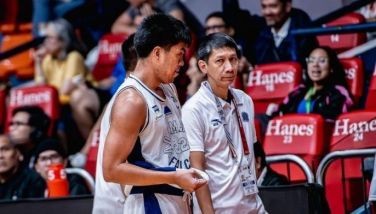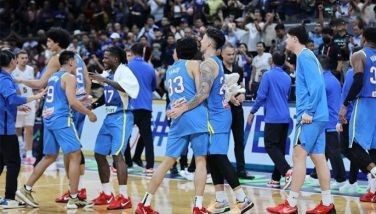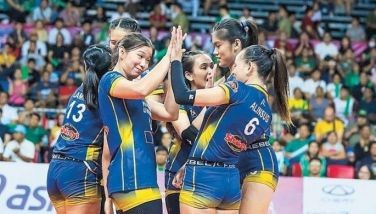The big build-up
November 17, 2001 | 12:00am
The marketing phenomenon of the UAAP men’s basketball games has spurred fevered interest in college basketball. Now that the cheering has died down and the confetti has been swept away, various groups are working in the background to either simulate or build upon the runaway success of the UAAP.
Many figures have been bandied about as representative of the revenue generated by the short college tournament. Some say it raked in about P60 million, a comparative bonanza when ranked beside the amount projected as earnings of the MBA, which is in a state of transition. But then again, the UAAP is the new fair-haired child of Philippine basketball, thanks largely to its organization, and the awareness campaign waged successfully by ABS-CBN’s Studio 23.
Now the search is on for similar "products" that may also be turned into financial and television blockbusters. Some businessmen are considering repeating the process with the NCAA; some want to try creating a new league. Still others are considering going nationwide, if the financials look good.
In the United States, college basketball is huge, larger, in fact, even than the NBA when it is on. That’s why colleges have also expanded their sports programs, because it is one sure way to pull in large amounts of money from alumni and sponsors. College coaches themselves have endorsement contracts with sports shoe manufacturers, primarily because they can guarantee that the whole team will be wearing that brand.
Here in the Philippines, we are at a turning point. Schools realize that there’s money to be had in basketball. Some dismayed UAAP contenders are already building up for next year, madly recruiting from the provinces. Their one target: players with size. It will not be uncommon to have three or four players 6-5 and up on a single team by next season, mark my word.
Unfortunately, there is already a brewing sentiment that the desire to win is being carried a bit too far. Expect more investigations into player age and eligibility in the next season, as schools go farther and farther in recruiting Fil-Am players and rookie from distant parts of the archipelago.
The next question is: where will it stop? And who will regulate it? I ask these questions now before the boom in university hoops hits full swing. I’ve already heard conversations among high-powered alumni of various colleges inquiring about the costs of putting up their own league and having the games televised. It’s one thing to have a league run by sportsmen. It’s another to have one spawned by hardcore business executives. We’ve already seen how the birth of professional basketball in this country has caused problems for amateur basketball, and how players in the PBL have been squeezed into choosing between school and playing for pay if they are branded professionals.
There will also be the question of allegiance. If a year-round college basketball circuit is put up, what happens to the PBL (which plays when there is no college basketball) and the NBL (which is made of college players who also see action in the PBL)? Once again, the players will be made to choose.
The good thing about this is that schools from the Visayas and Mindanao, or at least some of their players, will be given exposure. Proud institutions like the University of the Visayas and Ateneo de Davao may finally receive their due after years of producing some of the country’s best pros and even representing the Philippines in international competition. Up north, Baguio, somewhat isolated because of distance, has a very fertile basketball community, thanks largely to Leo Arnaiz’s Athletes Haven. All these are large, untapped markets with an existing basketball culture. Once travel logistics are resolved, there’s no reason why they can’t be ranged against the best schools in Metro Manila.
To be sure, there are many different styles of play all over the country, from Cagayan de Oro to Pampanga, La Union to General Santos. And who can really say which influenced the other? With the PBA, MBA and PBL becoming such high-profile melting pots, who can tell where the style from one geographical area ends and the other begins?
If there were to be a true national basketball league, then we would have a tremendous opportunity to learn from each other, and boost the sport even further.
Now that would be exciting.
Many figures have been bandied about as representative of the revenue generated by the short college tournament. Some say it raked in about P60 million, a comparative bonanza when ranked beside the amount projected as earnings of the MBA, which is in a state of transition. But then again, the UAAP is the new fair-haired child of Philippine basketball, thanks largely to its organization, and the awareness campaign waged successfully by ABS-CBN’s Studio 23.
Now the search is on for similar "products" that may also be turned into financial and television blockbusters. Some businessmen are considering repeating the process with the NCAA; some want to try creating a new league. Still others are considering going nationwide, if the financials look good.
In the United States, college basketball is huge, larger, in fact, even than the NBA when it is on. That’s why colleges have also expanded their sports programs, because it is one sure way to pull in large amounts of money from alumni and sponsors. College coaches themselves have endorsement contracts with sports shoe manufacturers, primarily because they can guarantee that the whole team will be wearing that brand.
Here in the Philippines, we are at a turning point. Schools realize that there’s money to be had in basketball. Some dismayed UAAP contenders are already building up for next year, madly recruiting from the provinces. Their one target: players with size. It will not be uncommon to have three or four players 6-5 and up on a single team by next season, mark my word.
Unfortunately, there is already a brewing sentiment that the desire to win is being carried a bit too far. Expect more investigations into player age and eligibility in the next season, as schools go farther and farther in recruiting Fil-Am players and rookie from distant parts of the archipelago.
The next question is: where will it stop? And who will regulate it? I ask these questions now before the boom in university hoops hits full swing. I’ve already heard conversations among high-powered alumni of various colleges inquiring about the costs of putting up their own league and having the games televised. It’s one thing to have a league run by sportsmen. It’s another to have one spawned by hardcore business executives. We’ve already seen how the birth of professional basketball in this country has caused problems for amateur basketball, and how players in the PBL have been squeezed into choosing between school and playing for pay if they are branded professionals.
There will also be the question of allegiance. If a year-round college basketball circuit is put up, what happens to the PBL (which plays when there is no college basketball) and the NBL (which is made of college players who also see action in the PBL)? Once again, the players will be made to choose.
The good thing about this is that schools from the Visayas and Mindanao, or at least some of their players, will be given exposure. Proud institutions like the University of the Visayas and Ateneo de Davao may finally receive their due after years of producing some of the country’s best pros and even representing the Philippines in international competition. Up north, Baguio, somewhat isolated because of distance, has a very fertile basketball community, thanks largely to Leo Arnaiz’s Athletes Haven. All these are large, untapped markets with an existing basketball culture. Once travel logistics are resolved, there’s no reason why they can’t be ranged against the best schools in Metro Manila.
To be sure, there are many different styles of play all over the country, from Cagayan de Oro to Pampanga, La Union to General Santos. And who can really say which influenced the other? With the PBA, MBA and PBL becoming such high-profile melting pots, who can tell where the style from one geographical area ends and the other begins?
If there were to be a true national basketball league, then we would have a tremendous opportunity to learn from each other, and boost the sport even further.
Now that would be exciting.
BrandSpace Articles
<
>
- Latest
- Trending
Trending
Latest
Trending
Latest
Recommended




























